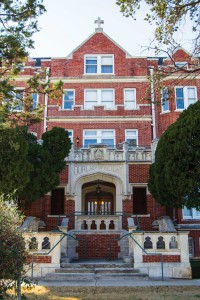When her order asked Menotti to move to California to teach, she rode the train west with her friend Francesca Walterscheid. The two had met in Dickinson when Walterscheid was teaching at the Catholic school. Originally from Muenster, Texas, Walterscheid had joined the order in 1949 when she was 18.
Menotti and Walterscheid both recall Menotti riding her horse, Danny, over to visit Walterscheid, who lived next door to the schoolhouse.
“She thought I’d spook the horse in my long, black habit, but I didn’t,” said Walterscheid, a petite woman now in charge of kitchen and house maintenance at Our Lady of Victory Center.

In Hollister, south of San Jose, Walterscheid served as school principal at Sacred Heart Parish School, and Menotti taught sixth grade. The two lived in what Menotti described as a beautiful two-story stucco building.
“It was quite a bit for us country girls,” she said.
That was in the 1960s, the decade when, as Menotti said, the nuns “kind of streamlined” their mode of dress. The sisters removed the headbands they normally wore under their habits, allowing wisps of loose hair a taste of freedom.
But on weekends, when Menotti rode horseback with a friend over the California hills, she did so in full habit. The long outfit, in a lightweight woolen fabric, was “real hot,” Menotti said. It wasn’t until later that the pope allowed the nuns to modify their habits.
“It’s an option,” said Menotti, dressed in a yellow sweater and pants with her cowboy hats hanging nearby. “I haven’t been in the habit since ’69.”
Menotti and the other sisters eventually left Hollister, she said, because there were not enough nuns to staff the school, which was closed and turned into parish offices.
Menotti, who took vows of chastity, poverty, and service, said she received “very little” pay at the time.
Nadia Lahutsky, Texas Christian University associate professor and Department of Religion chair, said that, historically, many Catholic women became nuns because career options for them were so few and because the church would educate them as nurses and teachers.
“They staffed the hospitals. They found a life outside of motherhood,” she said. “You can imagine you paid the nuns a pittance for the labor they [did].”
In the 1960s and ’70s, the women’s movement came along, as did the modernization of church practices. And the numbers of women joining convents dropped dramatically.
“Think of it [their numbers] as dropping like a rock,” Lahutsky said. “I think with fewer sisters to staff them, many churches closed their schools. It costs a lot of money to run a school — especially if you are paying laymen and women a moderately competitive salary.”
Menotti said that the lay people who work as teachers and school administra-tors today are doing a good job, but that an element of religious presence is lost without the nuns.
Only two of the four Fort Worth Catholic schools listed on Menotti’s service record remain open, she said. One of those, Saint Andrew Catholic School at 3304 Dryden Rd., has about 700 students, both Catholic and non-Catholic. It was founded by the Sisters of Saint Mary of Namur, who once lived on the school grounds, said school president Charles Llewellyn. Currently, no nuns teach at the school.
According to the Center for Applied Research in the Apostolate, a Catholic research organization, there is about half the number of Catholic elementary schools in the United States today compared to 1965. While there are about 35 percent fewer priests in the U.S. today than in 1965, the number of nuns has dropped by more than 72 percent.
Schoolteachers in those days were mostly nuns working “for the good of the church,” Llewellyn said. “Back in the day, you didn’t have a high payroll.”
Now, he said, “There has to be a good salary that is [competitive] to get good people who want to come work here,” he said. Plus, “fewer people are feeling the call to religious life.” But, he added, “the bishop wants to do everything he can to keep the schools open and running regardless of the numbers.”
Menotti said that in third-world countries, convent life is still attractive to women because of the educational opportunity it offers.
******












What an interesting and inspiring story of life.